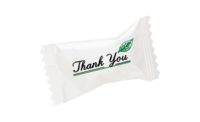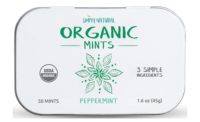
It’s Horatio Alger meets Vin Diesel; Candy Land adjoined to Hollywood; mints as part of the tool kit. Given these incongruities, most business school alumni might find Wrench Mints’ success amazing, particularly since 40% of most new businesses fail in the first year.
And considering the large number of mint companies that surfaced and then disappeared during the past four years, it’s encouraging to hear that this confectionery startup remains engaged and earnest.
But after one meets Eddy Rubin, ceo and co-founder of the company, it’s clear why Wrench Mints not only survived the 2008/2009 recession, but is poised to torque up its growth plan several notches.
The Motown-turned-La La Land entrepreneur - Rubin was born in Detroit in 1968 and moved to Los Angeles with his family in 1985 - received his inspiration eight years ago from aHint Mint tin he had purchased and tucked away in his drawer for half a year.
When Rubin serendipitously took a second look at theHint Minttin, the budding actor had an epiphany: he realized that the ubiquitous mint could address not only flavor, but form and fashion.
In Rubin’s case, his fashion model didn’t focus on glam. Instead, it was all about the grip, as in gripping a tool - literally, a wrench-shaped mint that could fix bad breath.
Identifying with America’s penchant for tools and a do-it-yourself mentality, Rubin spent four years developing the product and searching for investors, testing prototypes for the right flavor and shape.
Ironically, it was Rubin’s best friend, Johnny Alper, who eventually provided the seed money to getWrench Mintsoff the ground.
“It was as if he [Alper] also had an epiphany,” Rubin says. “I had been talking to him about the concept for about two to three years. And he would always wish me luck. Then one day he calls me and starts telling me that I could sell the mint here, do that with this company. And I said, yea, that’s what I’ve been telling you all along. That’s when he came on board and invested $100,000.”
With the seed money, Rubin was able to finalize the product and packaging, both of which are patented. He still needed someone to manufacture it, however. After soliciting several mint co-manufacturers, Rubin settled on F&F Foods.
“They’re the one that sent me back the best sample,” he says. “It was the beginning of a business relationship that turned into a friendship.”
As David Barnett, president of Chicago-based F&F Foods, explains, he didn’t quite know what to do with this “nut,” an actor-turned-mint marketer. But as Barnett has learned from his years in the confectionery business, one never knows where the next great candy concept will spring from.
“During the past five to seven years, the mint category has gone through a number of peaks and valleys,” he explains. “There were quite a number of companies who simply wanted to make a quick hit. As it turns out, many of those that were in the mint category are no longer in it.
“Wrench Mintsis a unique product,” Barnett continues. “It appeals to both the mainstream market as well as to specialty sectors. And you can’t downplay the packaging component, because it’s part of the appeal.”
Rubin, however, will be the first to tell anyone that pizzazz doesn’t immediately translate into placement. Still, in its first debut at the National Hardware Show in May 2007,Wrench Mintsproved it had a following. Subsequent attendance at theAll Candy Expo(now theSweets & Snacks Expo) proved fruitful, as well. By the end of the year, the initial product run was sold out.
Hardware chains such as True Value, Harbor Freight Tools, Northern Tool and Equipment, Ace Hardware, ACO Hardware and Duluth Trading Co. bought into the idea of giving their customers “a tool to fix their breath.”
Spurred by their initial success, Rubin and Alper looked forward to growing the business. Of course, as many entrepreneurs come to realize, there are several stages in developing a growth curve. Hitting that million-dollar mark almost always proves to be one of the most challenging.
It becomes doubly difficult when economic conditions turn sour and retailers become reluctant to experiment with newcomers. Amazingly, despite such challenges, Rubin explains that 2009 was more mercurial than malevolent. Sales at the beginning of the year started well, but then shrank as the aftereffects of the lingering recession hit consumers hard, he says.
Having survived the bump in the road, Rubin credits his loyal consumer base with providing the foundation for future growth.
Quickly skimming over e-mails on his cell phone, the consummate salesman locates an inquiry from a customer. He displays a message from aWrench Mintsfan who feared the product was no longer available at a Woodcraft store. It seems an employee at the oldest woodworking retail chain in the United States told him the mint producer had gone out of business.
“This is a fellow who doesn’t just buy one tin ofWrench Mints; rather, he purchases a whole box that costs $24.00,” Rubin exclaims. “Well, I called him and reassured him we were still in business. He couldn’t believe that the ceo of the company was calling him.”
Such customer loyalty has convinced Rubin that the path to growth revolves around increasing distribution.
“I want to focus on growing our existing distribution while expanding into new outlets,” he says. “We’re looking at mass merchandisers, drug store chains, convenience stores as well as hardware stores and automotive outlets, which includes automotive departments in mass merchandisers.”
Rubin also points out that he’s unexpectedly received inquiries and orders from abroad, including Iceland, Singapore, Malaysia, United Arab Emirates and Dubai. Again, he sees this international grass-roots appeal as part of the inherent strength of the product and the package.
“When I developed the flavors, I wanted to make sure they appealed to mainstream America,” he says. Take our peppermint: it has a strong, crisp taste. Yet, when it dissolves in your mouth, it doesn’t overpower you; it’s just below that level.”
Today, in addition to peppermint,Wrench Mintscome in three other flavors: spearmint, cinnamon and candy cane.
As Barnett points out, in addition to winter green, peppermint, spearmint and cinnamon are the most popular flavor profiles in the mint category. Recognizing that consumers as well as customers are continuously looking for excitement in the confectionery category, F&F Foods’ president provides a sounding board for Rubin regarding new flavors.
For instance, Rubin thought it would make sense to add a licorice flavor to the company’s existing portfolio.
“I advised against it,” Barnett says. Although licorice has grown in popularity recently, it’s important to look beyond headlines and “see what’s happening in the market,” he adds.Besides, there are other ways to get consumers and customers excited. And packaging is certainly one avenue.
“Just look atCoke andPepsi,” Barnett says. “Both of them are iconic brands, but they’re still changing the designs on their cans.”
Next toWrench Mints’flavor profiles, the wrench-shaped tins and mints have been critical to establishing the product amongst retailers. Having subtly tweaked the colors of the mint tins, Rubin and Alper now are considering a more dramatic transformation.
“We’re looking at ‘manning it up,’” he says. In this instance, manning it up involves changing the color of the tin to black, with just a color accent for the specific flavor. “I’m thinking the tins could even become collector’s items.”
The possible packaging change coincides with Rubin’s plans to introduce television advertising. He’s already taken the first step toward garnering great public recognition by signing on as one of the sponsors of famed female jet-fueled dragster driver Jessie “Leadfoot” Harris, also known as the “Queen of Diamonds.”
Rubin’s plans for television commercials this year center on emphasizing the “fix-it” aspect ofWrench Mints. Of course, given his Hollywood connection, it involves both humor and beautiful women.
“My goal is to mandateWrench Mintsinto the fabric of society,” he says. “I realize it will take time, but I really want the product to become the Great American Mint.”
Horatio Alger would be proud.





